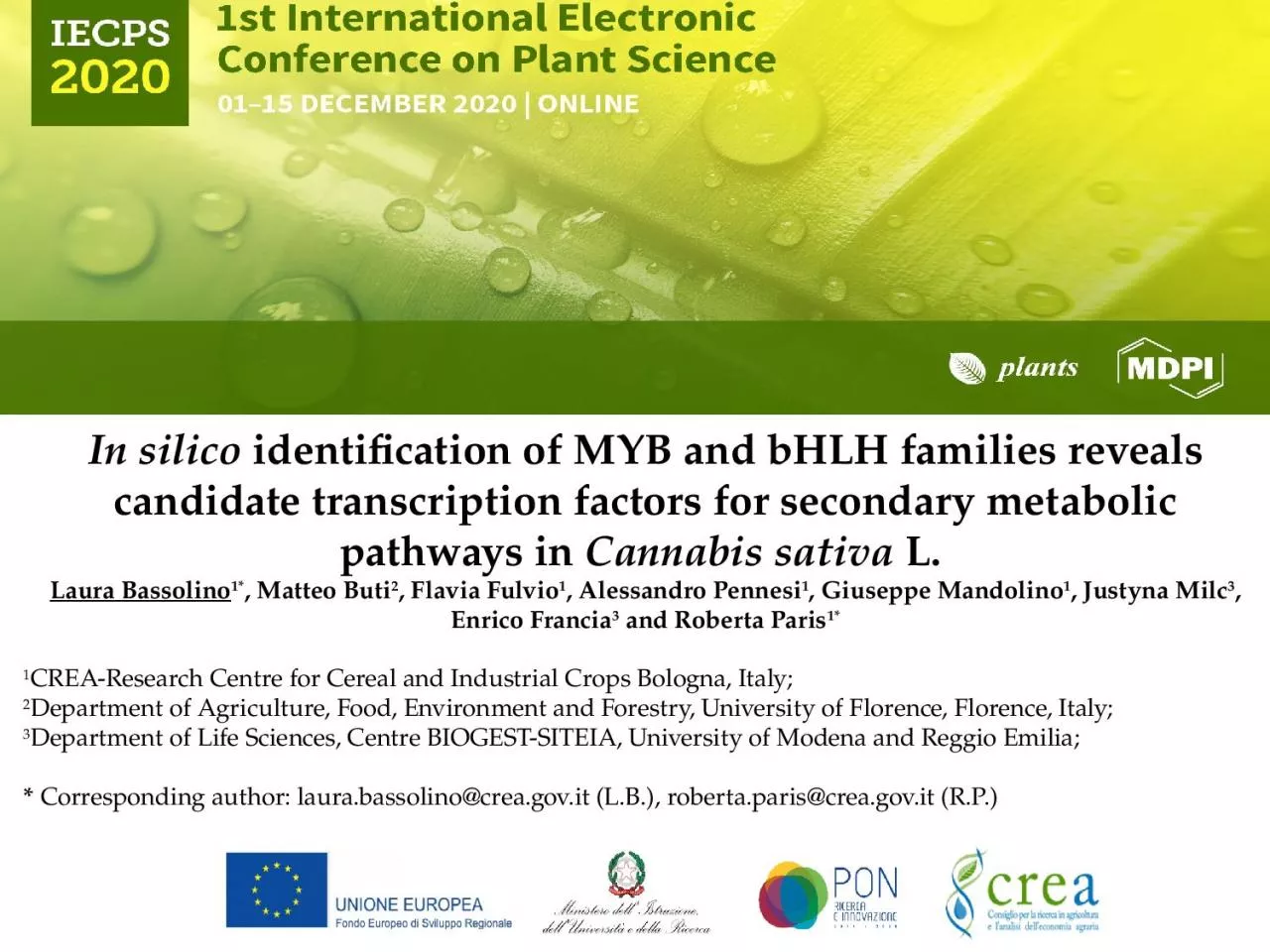

bHLH families reveals candidate transcription factors for secondary metabolic pathways in Cannabis sativa L Laura Bassolino 1 Matteo Buti 2 Flavia Fulvio 1 Alessandro Pennesi 1 ID: 1037447
Download Presentation The PPT/PDF document "In silico identification of MYB and" is the property of its rightful owner. Permission is granted to download and print the materials on this web site for personal, non-commercial use only, and to display it on your personal computer provided you do not modify the materials and that you retain all copyright notices contained in the materials. By downloading content from our website, you accept the terms of this agreement.
1. In silico identification of MYB and bHLH families reveals candidate transcription factors for secondary metabolic pathways in Cannabis sativa L. Laura Bassolino1*, Matteo Buti2, Flavia Fulvio1, Alessandro Pennesi1, Giuseppe Mandolino1, Justyna Milc3, Enrico Francia3 and Roberta Paris1*1CREA-Research Centre for Cereal and Industrial Crops Bologna, Italy; 2Department of Agriculture, Food, Environment and Forestry, University of Florence, Florence, Italy; 3Department of Life Sciences, Centre BIOGEST-SITEIA, University of Modena and Reggio Emilia;* Corresponding author: laura.bassolino@crea.gov.it (L.B.), roberta.paris@crea.gov.it (R.P.)
2. Abstract: Plant secondary metabolic pathways are finely regulated by the activity of transcription factors. Cannabis sativa L. is a unique officinal plant species with over 600 synthesized phytochemicals. Despite the high conservation of flavonoid biosynthetic routes in model and non-model plant species, a unique report does not exist to date on the characterization of structural and regulatory genes involved in flavonoid synthesis in Cannabis sativa L. Further, very little is known about the regulation of cannabinoids’ metabolic pathways. Thus, although performed exclusively in silico, this work represents the first comprehensive step in this direction. We performed a genome-wide analysis of bHLH and MYB families in C. sativa cs10 genome reference of cv. CBDRx. CsbHLHs and CsMYBs were classified into functional subfamilies via comparative phylogenetic analysis with A. thaliana. Analyses of gene structure and motif distribution confirmed that members of both superfamilies belonging to the same evolutionary clade share common features at both gene and amino acidic level. Structural enzyme-coding genes for flavonoid and cannabinoid synthesis were also identified via candidate gene approach. To summarize, candidate genes identified in silico are a valuable resource for further investigating of the C. sativa cannabinoids and flavonoids metabolic pathways for genomic studies and breeding programs.Keywords: Cannabis sativa; Genome-wide analysis; MYBs; bHLH; Flavonoids2
3. 3Results and Discussion. Comparative phylogenetic tree and classification of bHLH proteins in Cannabis sativa and Arabidopsis thaliana. anthocyanins and trichomes-related bHLH
4. 4Results and Discussion. Logo consensus sequences of bHLHs Subfamily from Cannabis. Figure 3. The logo sequences of motif 1 and 2 represent the bHLH domain in Cannabis. The overall height of each stack indicates the conservation of the sequence at a certain position. Capital letters indicate >50% conservation of amino acids within the domains. The width of motifs is indicated by Arabic number under the colored letters, where each color represents a type of amino acid. Full sequences are listed in Supplementary Files S1.
5. 5Results and Discussion. Comparative phylogenetic tree and classification of MYB proteins in Cannabis sativa and Arabidopsis thaliana. flavonoids-related MYBs repressorsflavonoids-related MYBs activators
6. 6Results and Discussion. Logo consensus sequences of MYBs Subfamily from Cannabis. Figure 6. The logo sequences of motifs 3, 5 and 2 together constitute the R2 repeat, motif 1 correspond to R3 repeat of MYBs domain. Red stars indicate conserved tryptophan residues, while black stars mark other conserved amino acid residues discussed in the text. The overall height of each stack indicates the conservation of the sequence at a certain position. The capital letters indicate >50% conservation of amino acids within the domains. The motifs width is indicated by Arabic number under the colored letters, where each color represents a type of amino acid.
7. 7Results and Discussion: Chromosomal Distribution of Genomic Loci for CsMYBs, CsbHLHs, and biosynthetic enzymes for flavonoids and cannabinoidsFigure 7. Genomic loci corresponding to CsMYBs and CsbHLHs identified in this work are marked in blue and red, respectively. The position of genes encoding for flavonoid (in green) and cannabinoid (in red) enzymes is indicated by their acronym in capital letters on each chromosome
8. 8ConclusionsUnderstanding the regulatory players that control the synthesis of specific secondary metabolites, as well as the chromosomal distribution of genomic loci encoding target biosynthetic enzymes, will drive the discovery of molecular markers and QTLs for specific metabolic traits, thus boosting conventional breeding programs and genetic engineering strategies in Cannabis sativa L. Indeed, manipulation of biosynthetic pathways leading to specific bioactive plant-derived metabolites is mainly achieved by acting on master regulatory genes like transcription factors; thus, our results might represent a useful resource to develop such an approach in Cannabis.Further experimental strategies are required to fully characterized at functional level the candidate players for metabolic pathways identified in silico. To achieve this goal and study gene function in planta, biotechnological tools need to be implemented in Cannabis
9. 9Supplementary MaterialsLinks: https://www.mdpi.com/2223-7747/9/11/1540Bassolino, L.; Buti, M.; Fulvio, F.; Pennesi, A.; Mandolino, G.; Milc, J.; Francia, E.; Paris, R. In Silico Identification of MYB and bHLH Families Reveals Candidate Transcription Factors for Secondary Metabolic Pathways in Cannabis sativa L.. Plants 2020, 9, 1540.
10. 10AcknowledgmentsThis work was supported by UNIHEMP research project “Use of iNdustrIal Hemp biomass for Energy and new biocheMicals Production” (ARS01_00668) funded by Fondo Europeo di Sviluppo Regionale (FESR) (within the PON R&I 2017-2020− Axis 2 − Action II − OS 1.b). Grant decree UNIHEMP prot. no. 2016 of 27/07/2018; CUP B76C18000520005